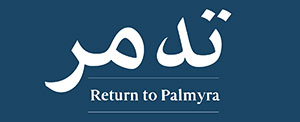
Portrait of Emily Anne Beaufort published in The Graphic, 1877. Source: Wikimedia Commons
In 1858, Emily Anne Beaufort decided to leave her native London to visit the city of Palmyra and other sites in the Middle East. Her interest in travel was sparked by her father Admiral Sir Francis Beaufort, who had journeyed widely in his career as a naval officer and a specialist in hydrography. A year after his death, Emily Anne and her sister traveled to Egypt, Lebanon, Syria, western Turkey, and Palestine. Ms. Beaufort published a vivid description of their trip in an 1861 book titled Egyptian Sepulchres and Syrian Shrines (available on the Internet Archive here). It reached a wide public who wanted to share in her experiences abroad, and was reissued in later editions.
In the preface to her book, Beaufort announced the goals of this publication: to provide an “armchair adventure” for those unable to make the trip and to encourage women that it was safe to undertake a similar journey without the necessity of male companions. The lively narrative and elaborate descriptions of people and places are enhanced by sketches that Beaufort made on her tour. Her drawings were used by Nicolas Hanhart to create color lithographs for the book.

Sheik Miguel, of the Anazeh Tribe, Nicholas Hanhart after Emily Anne Beaufort Smythe, Viscountess Strangford. Color lithograph, 6.4 x 3.9 in. From Emily Anne Beaufort Smythe, Viscountess Strangford, Egyptian Sepulchres and Syrian Shrines (London, 1862), facing page 330. The Getty Research Institute, 3026-718
Many entertaining anecdotes are interspersed throughout the narrative, making the reading of this memoir still pleasurable 150 years after its initial appearance. Beaufort vividly recounts having to hold down her petticoats as she is thrust feet-first by four men into a small opening that allows her to visit the interior of the temple at Abu Simbel in Egypt. Also, she advises future female visitors to the pyramids in Egypt to “be quietly passive in the hands of the three Arabs apportioned to each visitor…and to leave your crinoline in Cairo.” In other passages, she describes the exotic and colorful clothing worn by the native populations and compares the goods that can be purchased in the bazaars of Cairo, Constantinople, and Damascus. In Palmyra, the Sheik of Tadmor offered to “buy” Beaufort for the price of nine camels. When he discovered that she was very good at shooting a rifle, he raised the offer to ten.
In early editions of her book, Beaufort appended a list of items that would be useful for the female traveler. If visiting Syria, she recommends that every woman include the following items in the travel bag hanging from the pommel of the camel’s saddle: “a fan, some ammonia in case of scorpion stings and (more rarely) ant attacks, a book to read during the midday rest, drawing materials, needle and thread, a brush and soap in case you could have a quick scrub if you passed a fountain, and some dates, almonds and figs to eat since meals were often eaten at a very late hour.”
Above all, however, Beaufort clearly excels and delights in the description of the desert landscape. Many pages are devoted to the spectacular colors and changing atmosphere of the desert, a welcome respite from the foggy, gray skies of her native England. “There lay the desert in its apparently boundless infinitude,” she writes, “glowing in radiant colours of unnumbered variety; while [there] stood Tadmor (Palmyra), though in ruins, still empress of the plain, majestically grand!”

Panorama of Palmyra, Nicholas Hanhart after Emily Anne Beaufort Smythe, Viscountess Strangford. Color lithograph, 4.3 x 20.4 in. From Emily Anne Beaufort Smythe, Viscountess Strangford, Egyptian Sepulchres and Syrian Shrines (London, 1862), facing frontispiece. The Getty Research Institute, 3026-718. See this panorama larger.
When Egyptian Sepulchres and Syrian Shrines was published, it was reviewed by Percy Ellen Algernon Frederick William Sydney Smythe, eighth Viscount Strangford. He and Beaufort married in 1862, shortly after the book’s publication. As Viscount and Vicountess Strangford, they shared a love of travel and went to live in the Middle East.
In 1864, Lady Strangford published her second book, The Eastern Shores of the Adriatic, which included three chapters written by her husband. When she was widowed just five years later, she devoted the rest of her life and financial resources to the training of military nurses and the foundation of hospitals in Bulgaria, Turkey, and Egypt. Today she is primarily remembered for her work in the medical field. However, as the city of Palmyra continues to suffer damage at the hands of militants, Lady Strangford’s descriptions of the city have become more precious and poignant:
And we too turned away, our last look bent,
On those old Tombs, while, like a bright dream spent,
The wild, free life upon the Desert plain,
The beauteous and sublime infinitude,
The gorgeous colored ocean, rainbow hued,
Those rosy Temples with their golden stain,
All lovely things we shall not see again—Excerpt from a stanza of the poem “Farewell to Palmyra” (1861 edition, page 402)
See Jane Friedman and Peter Bonfitto discuss Lady Strangford’s travels in a Facebook Live video here.

See all posts in this series »





Very interesting, especially for those who Know Egypt & Syria as well as the other Arab countries ,especially we the educated Lebanese. Very interesting subject.
Very interesting article to read and share with clients. Always intriguing to learn about familiar places through different views.